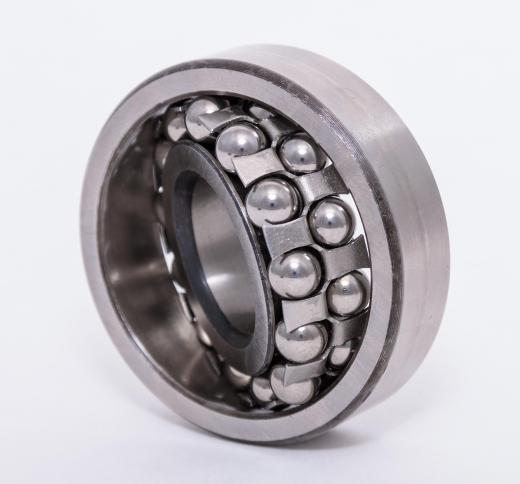A fluid bearing is a type of bearing that has no parts that actually come in contact with each other. Instead, a thin film of fluid, sometimes under pressure, serves to bear the entire load placed on the bearing. A fluid bearing can utilize a number of different fluids, oil being the most common, although water and even air are used in some types of fluid bearings. Intrinsically simpler than other bearings, a fluid bearing has many advantages over a standard ball bearing, which relies on a series of round steel balls or rollers to support the load on the bearing.
Most bearings of all types are designed to allow one part to move within an encasing part, usually by rotating or sliding in some fashion, like a spindle rotating within a collar in a high-speed lathe. Mechanical bearings, the most common the of which is the ball bearing, rely on actual moving parts to facilitate this movement. A fluid bearing, however, has no moving parts that make up the bearing itself, so the movement between the two components is supported instead by a thin layer of liquid. A fluid bearing may be a sealed system or may require a pump to maintain liquid pressure within the bearing itself.

A fluid-static bearing uses a pump to deliver the liquid and a fluid-dynamic bearing uses the movement of the parts themselves to draw the liquid into the bearing. Some fluid dynamic bearings may also use a supplemental pump for fluid delivery during start-up or shut-down operations to eliminate wear. Fluid-static bearings are often pressurized as a function of the operation of the fluid delivery pump system. Some types of fluid bearings may even use air or gas as a fluid.
Standard mechanical bearings have many disadvantages when compared to fluid bearings and few disadvantages. Fluid bearings are usually much quieter, exhibit much less wear, and can operate for extremely long periods with little or no maintenance, providing the fluid layer is maintained. Standard bearings tend to wear out and fail, especially under high-speed conditions. A fluid film bearing in a hydroelectric turbine plant in Pennsylvania is a well-known example. The original bearing, itself weighing over two tons, has supported a total load of close to 200 tons while under continuous use since its installation in 1912.
Fluid bearings, however, often consume more power due to their need for pumps for fluid delivery, and they do not perform well under conditions where a shock can be delivered to the bearing. A strong jolt to the bearing can result in the fluid film being compromised and the surfaces coming into contact, which, under extreme conditions, can result in a catastrophic failure. A fluid bearing may also be slightly less efficient than a standard bearing under similar operating conditions due to the viscosity of the fluid used.
